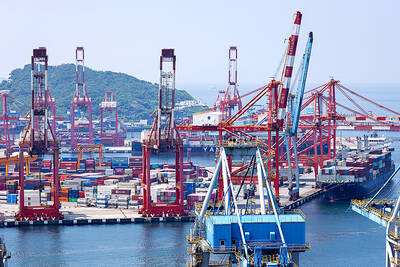United Microelectronics Co (UMC, 聯電), the world’s No. 3 contract chipmaker, yesterday said it would not consider rejoining the race to develop 7-nanometer (nm) technology after bigger rival GlobalFoundries Inc abandoned a plan to invest in it.
UMC in July last year said that it would not allocate capital for process technologies below 14 nanometers as it restructured to focus on boosting returns on investments.
The Hsinchu-based chipmaker said at the time that “it is difficult to address the 10-nanometer or 7-nanometer markets,” citing a smaller market size compared with less-advanced, but matured, technologies.
The company said its growth would come from end demand for Internet of Things and automotive applications, which do not required advanced chips.
When asked whether UMC would change its mind and redirect resources toward developing 7-nanometer technology, UMC co-president Chien Shan-chieh (簡山傑) said: “No, we won’t.”
Semiconductor companies face challenges to push technological boundaries because of costs and development hurdles, Chien said.
That is probably part of GlobalFoundries’ decision to halt development of 7-nanometer technology, he said.
Supply and demand imbalances, as well as a persistent shortage of silicon substrate are also challenges for chipmakers, he said.
Chipmakers have seen their 8-inch fabs under supply constraint, while 12-inch fabs have a supply surplus, he said.
“Our 14-nanometer [technology] is fully utilized currently. We have small 14-nanometer capacity,” Chien said. “Our 8-inch fabs are fully utilized” as well.
UMC declined to provide further information about its 14-nanometer technology, given its limited customer base.
The company in the second quarter last year had installed capacity to produce 2,000 12-inch wafers per month.
The chipmaker began shipping 14 nanometer chips, the most advanced technology offered by UMC, to clients in the second quarter of last year.
UMC said 14-nanometer technology contributed 3 percent of its revenue, which totaled NT$38.85 billion (US$1.27 billion) last quarter, up from 2 percent in the prior quarter and 1 percent a year earlier.
While 28-nanometer technology was the firm’s largest source of revenue, accounting for 26 percent last quarter, it was down from 30 percent in the first quarter due to sagging demand.
“UMC’s strategy is very clear. It is good, as the company focuses on more mature technologies, which deliver a higher gross margin,” Clark Tseng (曾瑞榆), director of the industry research and statistics unit of SEMI Taiwan, told reporters on the sidelines of a news conference in Taipei.
Taiwan Semiconductor Manufacturing Co (TSMC, 台積電) and Samsung Electronics Co are likely to be the main suppliers of 7-nanometer technology on a contract basis, Tseng said.
TSMC has led its rivals in ramping up 7-nanometer technology in the second quarter of this year.
China’s Semiconductor Manufacturing International Corp (中芯) has said it plans to invest in 7-nanometer technology, but it would lag far behind TSMC and Samsung for at least four or five years in offering such advanced technology, Tseng said.
Taiwan’s semiconductor industry is forecast to grow production value by 6 percent year-on-year to NT$2.61 trillion this year, Tseng said.
Next year, the growth rate is likely to accelerate to 8 percent and fall back to 6 percent in 2020 and 2021, or about NT$3 trillion, he said.

Nvidia Corp chief executive officer Jensen Huang (黃仁勳) on Monday introduced the company’s latest supercomputer platform, featuring six new chips made by Taiwan Semiconductor Manufacturing Co (TSMC, 台積電), saying that it is now “in full production.” “If Vera Rubin is going to be in time for this year, it must be in production by now, and so, today I can tell you that Vera Rubin is in full production,” Huang said during his keynote speech at CES in Las Vegas. The rollout of six concurrent chips for Vera Rubin — the company’s next-generation artificial intelligence (AI) computing platform — marks a strategic

REVENUE PERFORMANCE: Cloud and network products, and electronic components saw strong increases, while smart consumer electronics and computing products fell Hon Hai Precision Industry Co (鴻海精密) yesterday posted 26.51 percent quarterly growth in revenue for last quarter to NT$2.6 trillion (US$82.44 billion), the strongest on record for the period and above expectations, but the company forecast a slight revenue dip this quarter due to seasonal factors. On an annual basis, revenue last quarter grew 22.07 percent, the company said. Analysts on average estimated about NT$2.4 trillion increase. Hon Hai, which assembles servers for Nvidia Corp and iPhones for Apple Inc, is expanding its capacity in the US, adding artificial intelligence (AI) server production in Wisconsin and Texas, where it operates established campuses. This

Garment maker Makalot Industrial Co (聚陽) yesterday reported lower-than-expected fourth-quarter revenue of NT$7.93 billion (US$251.44 million), down 9.48 percent from NT$8.76 billion a year earlier. On a quarterly basis, revenue fell 10.83 percent from NT$8.89 billion, company data showed. The figure was also lower than market expectations of NT$8.05 billion, according to data compiled by Yuanta Securities Investment and Consulting Co (元大投顧), which had projected NT$8.22 billion. Makalot’s revenue this quarter would likely increase by a mid-teens percentage as the industry is entering its high season, Yuanta said. Overall, Makalot’s revenue last year totaled NT$34.43 billion, down 3.08 percent from its record NT$35.52

PRECEDENTED TIMES: In news that surely does not shock, AI and tech exports drove a banner for exports last year as Taiwan’s economic growth experienced a flood tide Taiwan’s exports delivered a blockbuster finish to last year with last month’s shipments rising at the second-highest pace on record as demand for artificial intelligence (AI) hardware and advanced computing remained strong, the Ministry of Finance said yesterday. Exports surged 43.4 percent from a year earlier to US$62.48 billion last month, extending growth to 26 consecutive months. Imports climbed 14.9 percent to US$43.04 billion, the second-highest monthly level historically, resulting in a trade surplus of US$19.43 billion — more than double that of the year before. Department of Statistics Director-General Beatrice Tsai (蔡美娜) described the performance as “surprisingly outstanding,” forecasting export growth